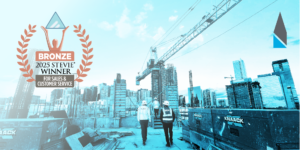After a fitful start, tariffs are officially here—and they are more extensive than anyone expected. The administration has implemented a 25% tariff on most goods coming from Canada and Mexico, a 10% tariff with 57 other trading partners, and an additional 1% to 50% tariff on select trading partners. For some countries, the tariffs are significant. China will face a total of 54% in levies, for example, while all goods from the European Union will face a 20% levy.
In response, the S&P 500 experienced a record two-day decline, losing $5 trillion in value, while many countries promised retaliatory countermeasures that could lead to a global trade war. The tariffs will have far reaching economic implications for everyone from the humblest consumer to the largest corporation. Commercial real estate developers—which track both consumer and business activity—are uniquely exposed to the impact of the new levies.
Short-Term Struggle with Potential for Long-Term Benefits
The aim of the tariffs is to generate revenue for the US and reshore manufacturing. Economists estimate that the tariffs will generate $400 billion in revenue, about 1.3% of GDP, making them the highest tax increase since the Revenue Act of 1968, according to Michael Feroli, chief U.S. economist at J.P. Morgan. Most economists also agree that the tariffs will slow economic growth and increase inflation. The tariffs will likely increase inflation by 1% to 1.5% this year, producing negative disposable income growth. As a result, consumer spending will likely contract in the second and third quarters, and the risk of a recession has grown to 40%.
However, there is also a silver lining. In the longer term, tariffs could help produce some economic growth. In three to five years, they could add 400,000 new manufacturing jobs, according to CBRE research, while noting that this figure does not account for jobs lost due to lower exports and retaliatory tariffs. In addition, CBRE says that the tariffs could help bring interest rates lower as The Federal Reserve seeks to stimulate economic growth.
Northspyre CEO William Sankey also sees the potential for long-term benefits. In an op-ed published in Commercial Observer, he wrote, “If tariffs drive more reshoring of manufacturing, industrial real estate could see a boost, and the supply chain may become more predictable and resilient with more domestic production of construction materials.” While the tariffs are still taking shape—new tariffs have been added suddenly and many world leaders have contacted the White House in an attempt to renegotiate the rate—they promise to be disruptive at least in the near term.
CRE Sectors Brace for Impact
The industrial and retail commercial real estate sectors will see the most immediate impact from the tariffs, because they are acutely exposed to consumer activity. The automobile industry will be among the most impacted by tariffs, alongside consumer goods, like mobile phones, televisions, apparel and toys. Industrial and retail properties supporting these goods will be disrupted as a result of reduced consumer spending and changes in the global flow of goods. CBRE expects that many companies will delay signing any new leases through the uncertainty, and many will rely more heavily on third-party logistics companies. At a recent NAIOP event, Eric Cox, senior vice president with CBRE’s National Partners Group, said that Asian third-party logistics companies have already been leasing large warehouse in Southern California in preparation for the higher tariffs. They now occupy 40% of the market.
Multifamily, along with hotels and offices, will see a secondary impact from the tariffs in the form of reduced economic growth, which will likely mean reduced demand and NOI as consumers find ways to offset higher household costs. Sankey also expects reduced new construction starts in multifamily as a result of the tariffs. “I expect even fewer projects to happen due to the increased construction costs, worsening the housing supply issue in the coming years and driving up rents,” he wrote. This could serve to intensify an already severe housing shortage in the country.
The construction industry is will see an outsized impact from the tariffs, as materials costs will increase significantly. According to JLL, one-third of all construction materials in the US are imported, and most come from China, Canada, or Mexico. CBRE expects that construction costs will immediately increase 3% to 5% in response to the tariffs alone. For many developers, this will feel like a pile on. The industry has already been hit hard by a global pandemic that disrupted supply chains and increased materials costs, as well as rapidly rising interest rates over the last two years.
Strategies to Mitigate Tariff-Related Costs
During a typical cost surge, developers will make an attempt to stockpile materials. However, JLL notes that isn’t financially feasible for most developers, who are already “stretched thin” after a tumultuous two years. In addition, because the tariffs are a steady, long-term cost increase—not a temporary increase due to a supply chain issue, for example—stockpiling goods doesn’t make a lot of sense. In addition, US manufacturers are not producing at high enough rates today to satisfy demand, so buying domestically also isn’t a viable option, at least in the near term.
So, what can developers do? Curtis Spencer, CEO of IMS Worldwide, recommends property owners and developers consider a Foreign-Trade Zone certification to help lower costs related to tariffs. A Foreign-Trade Zone is an area within the US that is considered outside of the bounds of Customs and Border Protection, and therefore can reduce duties and taxes. Spencer says that any site can qualify, including new construction and build-to-suit projects.
Investing in real estate technology can also help you mitigate risk amid supply chain tumult. Modern real estate development software allows developers to curb costs by creating efficiency throughout the project lifecycle to produce net cost savings. Look for an end-to-end development software that leverages AI, automation, and data analytics to produce supply chain resiliency, improve project planning, and identify alternative options when available. By relying on outdated and error-prone spreadsheets, you risk projects getting off schedule and over budget in a moment where managing finances is vital. Northspyre makes project delivery simple and ensures predictable outcomes, even when external market forces are introducing chaos into the development process.
Unfortunately, developers can’t change the tariffs or the cost of materials, but by remaining educated on the market and policy changes, reviewing potential responses, and investing in technology, developers can find a profitable path forward.
Book a demo and learn how Northspyre can help ensure predictable outcomes on complex development projects in any market environment.



